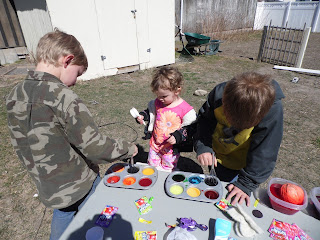I'm so excited to start on this little felting adventure... cuz I'm totally a
fiber nerd like that :).
My
first question is:
I read that felting makes a piece shrinks it.
But how much? Do different stitches shrink differently? What about the yarn, do
different brands shrink different? Roving vs regular yarn?
I started with a Skein (
I love saying that word, I think it is a trippy, slippery word) of Paton Roving in Yellow, Paton wool in blue, and Fisherman wool in white.
I wanted to use a couple different brands, and also see the difference between a roving and a worsted. Real quick the difference between roving and worsted weight yarn....
Roving is a single ply, very lightly twisted yarn.
It can be in any weight, but is usually bulky.
A Roving "Hides" the stitch more, it blends together more.
Worsted weight yarn is several plies and is twisted more.
I find that a worsted yarn gives a more distinct stitch,
you can see every twist of the yarn.
Now onto the fun stuff!
I want to see both how different yarns felt (Yes, yes, I know its really fulling) as well as how different stitches felt. With each yarn I made samples squares of ea Sc, Hdc, and Dc. To Felt it I set my
top loader on hot, small load. I didn't add soap because I hear that washing machines have a build up of soap and you can get away with doing a load without soap every now and again. I added in a couple pairs of my husbands jeans and let it
agitate for 10 minutes, then I turned it straight to spin and let it finish the cycle.
Lets start with the Paton Roving Sc: Starting measurements were 5x4.25
After Felting it shrunk to: 4.25x4
As you can see it shrunk width wise as well. It also thickened up a good amount, much more than either worsted yarn did. It did start as a bulky yarn (5), when the others were a Worsted (4), but even with that it still ended up thick.
Here are the original measurements:
Before Felting
|
SC
|
HDC
|
DC
|
Yellow
Roving
|
5x 4.25
|
5x 4.75
|
5x 4.5
|
White
Fisherman
|
4x 3.5
|
4x 3.75
|
4x 3.75
|
Blue
Worsted
|
4.25x 3.75
|
4.25x 6
|
4.25x 4
|
And the Measurements after Felting:
After Felting
|
SC
|
HDC
|
DC
|
Yellow
Roving
|
4.25x 4
|
4.25x 4
|
4.25x 3.5
|
White
Fisherman
|
3.25x 3.25
|
3.25x 3.25
|
3.25x 2.75
|
Blue
Worsted
|
3.25x 3.25
|
3.25x 5.5
|
4x3
|
A Couple of things I learned and noticed:
The roving felted thick! It also meshed the stitches more than either worsted yarn did. The Roving also ended up fuzzier. I'm so excited to use the roving to make nice thick, warm, fuzzy animal hats for my kiddos.
Not every square felted uniformly. Ok this one was partially my fault, but it was a good lesson to learn. I had left long tails... because I was lazy, to see what happened. Some of the tails twisted together and caused the piece to deform a little.
This is the Blue hdc sample after felting. the top and bottom where the loose ends got twisted ended up wider than the middle.
Felting, I mean Fulling, completely did away with any holes in my work. It is great for a really warm hat, or blanket.
I loved this adventure and can't wait for the next experiment!!
Next I want to play with dyeing. I'm excited to see how everything I want to try turns out.
Next time:
What
is all this wonderfulness I read about dyeing with Kool Aid, Can it really work
that amazing?
-I am going to dye some bows both in solid colors, and I'm going to attempt to do a few multicolors.
-How about dyeing a whole ball of yarn in an attempt to get a nice slow varigation. Have I mentioned how much I love a good slow varigation and how hard they are to find!
-What about RIT dye? The instructions sound more complex then kool-Aid. What would happen if I used RIT the same as Kool-Aid?
-How about dyeing a finished piece in order to get that perfect slow variegation that I love?










